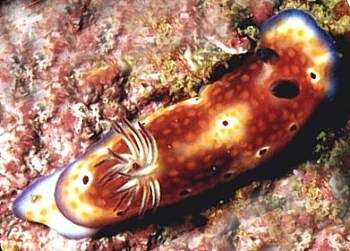
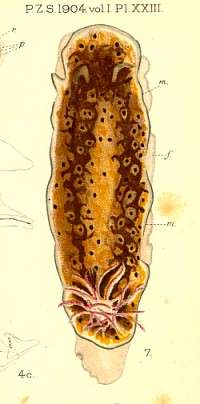
Chromodoris cavae
Eliot, 1904
Order: NUDIBRANCHIA
Suborder: DORIDINA
Superfamily: EUDORIDOIDEA
Family: Chromodorididae
DISTRIBUTION
East Africa [known only from Kwa Zulu-Natal, South Africa & Zanzibar, Tanzania].
PHOTO
UPPER: Port Shepstone, South Coast KwaZulu/Natal,- SOUTH AFRICA. Near Rocky Reef, 24m, October 1999. Size: 50mm. PHOTO: Valda Fraser.
LOWER: Holotype. Plate 24, fig 7. Eliot 1904. PAINTING: C. Crossland.
Note added 4 May 2007: See message #19876 for a discussion on colour variation in Chromodoris cavae.
In an earlier publication (Rudman, 1987) I considered C. cavae and C. vicina Eliot, 1904, both described from Zanzibar, East Africa, to be synonyms of C. tennentana Kelaart, which was described from Ceylon [Sri Lanka].
I still believe C. vicina is a synonym of C. tennentana but Valda Fraser's photo from South Africa clearly confirm that C. cavae is a distinct species. Below are Crossland's notes on the living animal, which formed part of Eliot's description. I also include Crossland's painting which matches Valda's photo well, except for the extra dark spots, which I assume are variable. Gosliner's (1987) photo 109,(p.75) as C. vicina is very similar to Crossland's painting with many more purple spots than in Valda Fraser's photos.
"Several specimens from the East and West Coasts of Zanzibar.
The following are the notes on the living animal:- Colour yellowish white, with indefinite large drab blotches laterally. Edges of mantle and foot bordered with light violet. On the back are black spots surrounded by a white line and also irregular dull orange spots. The foot is not very broad, white in colour, with a row of dull orange spots and black spots below them. The tip and anterior side of the rhinophores are purple; the lamellae are reduced to fine striations" ..... Eliot, 1904
See Valda Fraser's messages below.
References:
•Eliot, C.N.E. (1904) On some nudibranchs from East Africa and Zanzibar. Part IV. Proceedings of the Zoological Society of London, (1904): 380-406.
•Rudman, W.B. (1987) The Chromodorididae (Opisthobranchia: Mollusca) of the Indo-West Pacific: Chromodoris epicuria, C. aureopurpurea, C. annulata, C. coi and Risbecia tryoni colour groups. Zoological Journal of the Linnean Society, 90: 305-407.
Rudman, W.B., 1999 (November 12) Chromodoris cavae Eliot, 1904. [In] Sea Slug Forum. Australian Museum, Sydney. Available from http://www.seaslugforum.net/find/chrocava
Related messages
Re: Chromodoris cavae feeding
August 28, 2008
From: Colin Ogden
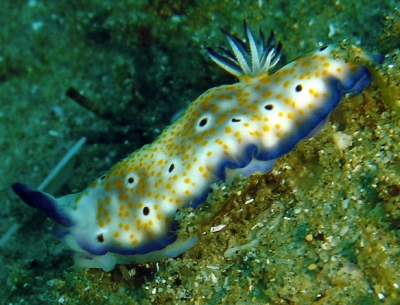
Concerning message #19883:
Hi Bill,
At last I have found my own Chromodoris cavae. (the previous ones had all been found by my staff members in rock pools). This one was on our dive yesterday and appears to be feeding. The strata on which it is feeding appears to be very much like the strata on which both the C. conchyliata, and the C. mandapamensis feed. I hope you can id the food source.
Locality: Sowana Bay, 14 metres, South Africa, Indian Ocean, 11 November 2007, reef. Length: 45 mm. Photographer: Colin Ogden.
Regards
Colin
scubaco@iafrica.com
Ogden C. M., 2008 (Aug 28) Re: Chromodoris cavae feeding. [Message in] Sea Slug Forum. Australian Museum, Sydney. Available from http://www.seaslugforum.net/find/21113Thanks Colin,
This could be an animal just off for a walk, or if there is a sponge present, it must be covered with sand. Unfortunately, I can see no sign of food.
Best wishes,
Bill Rudman
Re: Chromodoris cavae from South Africa
May 7, 2007
From: Colin Ogden
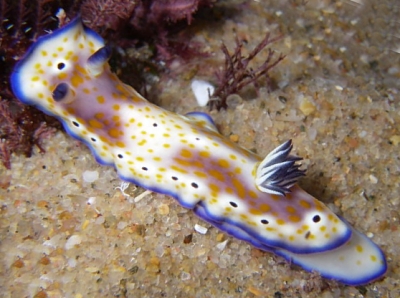
Concerning message #13967:
Hi Bill,
Thanks for the response on the C. tennantana. I have some more photos from some of my staff members of a nudi which could be C. cavae. Both of these were taken in the rock pools at Jesser point. I would appreciate your opinion on these. I have noted your comments [message #19862] also about Chromodoris cf. geminus which we also find here.
Locality: Sodwana Bay, .3 metres, South Africa, Indian, March 2006, rock pools. Length: 20 mm. Photographer: Nix Orban (lower photo) & Jesse Felthuis (upper photo).
regards
Colin
scubaco@iafrica.com
Ogden C. M., 2007 (May 7) Re: Chromodoris cavae from South Africa. [Message in] Sea Slug Forum. Australian Museum, Sydney. Available from http://www.seaslugforum.net/find/19883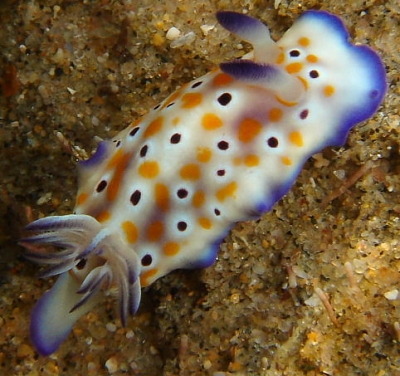
Dear Colin,
These are a valuable addition as they show two more variations of what I think are Chromodoris cavae.
The upper photo is quite similar to an earlier one from South Africa [message ##1486] in having very few purple spots, but differs in lacking the brownish background colour of that specimen. Looking at this photo it makes me wonder whether this colour form of C. cavae is the answer to the Risbecia ghardaqana puzzle [see message #9625]. If there is a form of C. cavae which looks like this but has also lost the few remaining purple spots it would be a close to perfect match for R. ghardaqana, as species which has never been confidently re-indentified since its original description.
The animal in the lower photo is quite similar to the photo we have from Kerala in India [message #8894] but the diffuse yellow spots have become larger and orange-brown, illustrating a step before the fusion of these brownish spots into the solid brownish patch seen in photos G-K in message #19876 ]
I never thought a few days ago that one message from Reunion Is would lead to this interesting 'shake-out' of these Indian Ocean purple-spotted chromodorids. All we need now is some information on their eggs and feeding habits.
Best wishes,
Bill Rudman
Re: Chromodoris cavae from Reunion Island?
May 4, 2007
From: Philibert Bidgrain
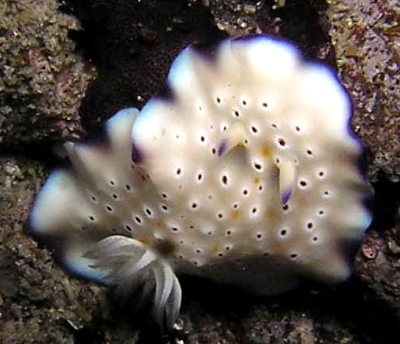
Concerning message #19869:
Dear Bill,
Colour morphs of Chromodoris cavae from Reunion Island
Here is another specimen from: Etang salé, Less 1 m, Réunion Island, Indian océan, Rocky coast. Photographer: Philibert Bidgrain.
Philibert Bidgrain
http://vieoceane.free.fr/runseaslug/indexslug.htm
pbidgrain@yahoo.fr
Bidgrain, P., 2007 (May 4) Re: Chromodoris cavae from Reunion Island?. [Message in] Sea Slug Forum. Australian Museum, Sydney. Available from http://www.seaslugforum.net/find/19870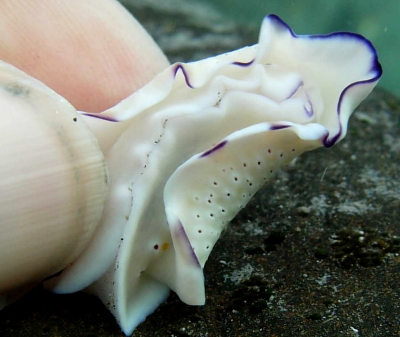
Dear Philibert,
This is almost identical to the colour form of C. cavae in Hugues Flodrops message [#19851 ] which started this flood of photos showing different colour forms. However it has a valuable difference which helps link it to some of the other colour forms. If you look carefully there are diffuse orange-brown spots scattered over the mantle which link it to the C. cf. geminus colour form where all the background is orange-brown.
Best wishes,
Bill Rudman
Re: Chromodoris cavae from Reunion Island?
May 4, 2007
From: Philibert Bidgrain
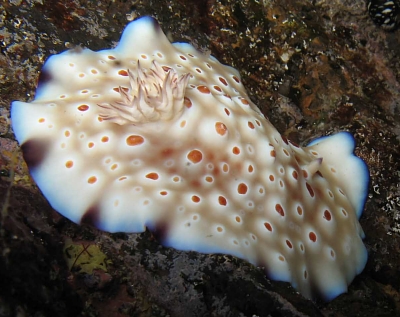
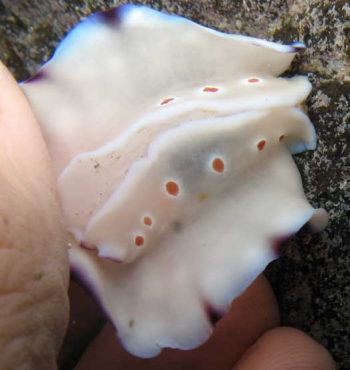
Concerning message #19851:
Dear Bill,
Colour morphs of Chromodoris cavae from Reunion Island
I found on a rocky coast 5 specimens of this species. The size ranges from 20-25 mm lower photo] to 45 mm [upper photo]. We can observed some colour variation on the mantle coloration.
Do you think that all these specimens are C. cavae? What's the external difference between C. cavae and C. tennentana?
Locality: Etang salé, Less 1 m, Réunion Island, Indian océan, Rocky coast. Length: 20 to 45 mm. Photographer: Philibert Bidgrain.
Philibert Bidgrain
http://vieoceane.free.fr/runseaslug/indexslug.htm
pbidgrain@yahoo.fr
Bidgrain, P., 2007 (May 4) Re: Chromodoris cavae from Reunion Island?. [Message in] Sea Slug Forum. Australian Museum, Sydney. Available from http://www.seaslugforum.net/find/19869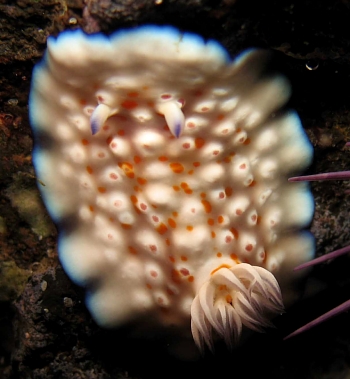
Dear Philibert,
Yes I agree this is a colour form of C. cavae. The orange spots surrounded by a whitish ring are an interesting example of how black and dark purple pigments in a number of chromodorids can be replaced by an orange-brown colour at times. This is a valuable complement to your messages #19868 and # 19870.
I have discussed C. cavae and C. tennentana in a separate messages [#19876; #19875]. Because of the great variability in colour in C. cavae comparisons between the two species is difficult, but the rhinophore and gill colours is quite distinct. In C. tennentana the rhinophore club is brownish to reddish brown with a white tip and the gills are usually a dark brown, sometimes with white spots. In C. cavae the rhinophores and gills are white with pale purple tips, but as I discuss, in southern specimens the purple can be more dominant.
Best wishes,
Bill Rudman
Variation in Chromodoris cavae
May 4, 2007
From: Bill Rudman
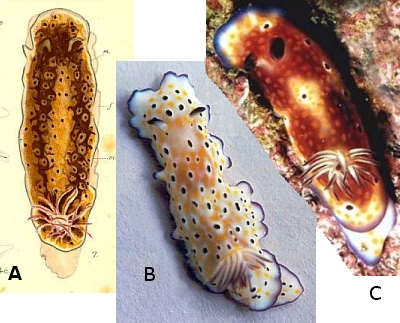
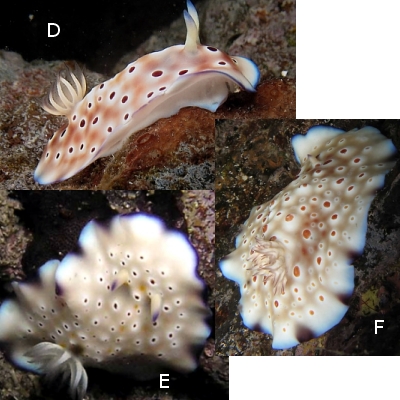
I have prepared a summary on C. tennentana [message #19875] to accompany recent messages concerning Chromodoris tennentana . There have also been many other messages showing one, or a number of other purple-spotted species, from the Indian Ocean. I present here a summary showing why I think all this variation is colour variation in a single species,Chromodoris cavae.
Chromodoris cavae was first described from Zanzibar (Eliot, 1904) and the description included a good colour description and painting of the living animal which can be seen on the Fact Sheet. I have repeated the colour description below and accumulated photos from the various messages on the Forum to show how the various colour variants merge into one another.
Chromodoris cavae
"Several specimens from the East and West Coasts of Zanzibar. The following are the notes on the living animal:- Colour yellowish white, with indefinite large drab blotches laterally. Edges of mantle and foot bordered with light violet. On the back are black spots surrounded by a white line and also irregular dull orange spots. The foot is not very broad, white in colour, with a row of dull orange spots and black spots below them. The tip and anterior side of the rhinophores are purple; the lamellae are reduced to fine striations"..... Eliot, 1904
Like C. tennentana, this species has dark purple spots ringed with white, and a washy purple border to the foot and the mantle. It may have yellowish spots, but they are larger and more diffuse than in C. tennentana, and are intermingled with the purple spots rather than restricted to the outer mantle. One consistent difference in C. cavae, is that the gills and rhinophores are white with washy purple tips. In some colour extremes the purple becomes more dominant, with the rhinophore clubs becoming dark purple and the gills becoming lined with purple, but that is most unusual, and quite different from the colours of C. tennentana.
Specimens from Reunion Island show an incredible range of variation, including forms in which the diffuse yellow-orange spots become browner and expand to form one large brownish patch. In the most extreme form of this pattern, the purple spots become fewer and much larger and all the mantle, except for a narrow white band at the edge, becomes a uniform yellow-brown background. I had earlier separated specimens from South Africa with that colour pattern into a separate 'species' which I called Chromodoris cf. geminus, but the photos we now have from Reunion Is, Mauritius and South Africa suggest that this is just an extreme colour variant of C. cavae.
I could of course be quite wrong, but for those who believe in parsimony, this seems to be a much more parsimonious hypothesis than 5 or 6 new species.
-
Eliot, C.N.E. (1904) On some nudibranchs from East Africa and Zanzibar. Part IV. Proceedings of the Zoological Society of London, (1904): 380-406.
Bill Rudman
Rudman, W.B., 2007 (May 4) Variation in Chromodoris cavae. [Message in] Sea Slug Forum. Australian Museum, Sydney. Available from http://www.seaslugforum.net/find/19876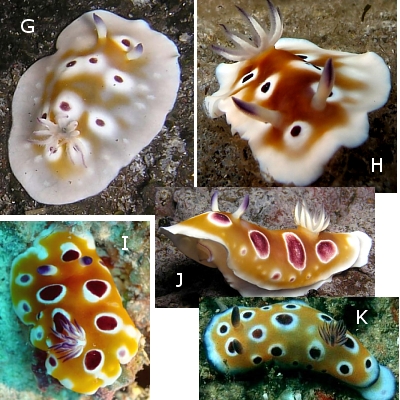
PHOTOS: A, original painting of C. cavae.
B, message #8894 India.
C, #1486 S. Africa.
D, #19851 Reunion Is.
E, #19870 Reunion Is.
F, #19869 Reunion Is.
G, #19868 Reunion Is.
H, #19862 Reunion Is.
I, #8271 Mauritius.
J, #19868 Reunion Is.
K, #1516 Sth Africa.
Re: Chromodoris cavae from Reunion Island?
May 4, 2007
From: Hugues Flodrops
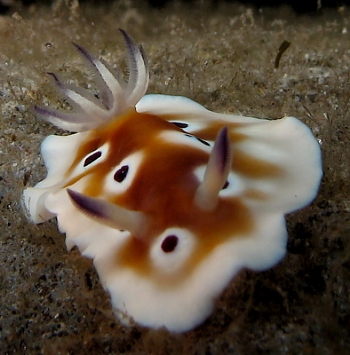
Concerning message #19851:
Dear Bill,
As you asked to complete "Risbecia tryoni group", here are two pictures ofChromodoris cf geminus from Reunion Island.
Locality: Etang-Salé, two metres, Reunion Island, Indian Ocean, 12 April 2007. Length: 25 mm. Photographer: Hugues Flodrops.
Sincerely yours,
Hugues.
hugues.flodrops@wanadoo.fr
Flodrops, H., 2007 (May 4) Re: Chromodoris cavae from Reunion Island?. [Message in] Sea Slug Forum. Australian Museum, Sydney. Available from http://www.seaslugforum.net/find/19862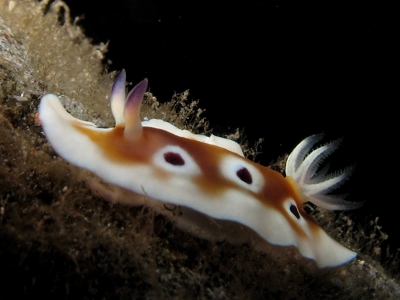
Dear Hugues,
Thanks for this quick reponse. Most of the messages I am posting today refer to the "Risbecia tryoni group" from the Indian Ocean, in particular Chromodoris cf geminus, C. tennentana and C. cavae. As I hope my separate discussion on colour variation in C. cavae [message #19876 ] will explain, I am now pretty sure this animal is a form of C. cavae which also suggests that C. cf. geminus is also a form of C. cavae rather than a different species. I guess the most conspicuous difference is that the animals from Sth Africa which I initially called Chromodoris cf. geminus have much more purple in the rhinophore club than your animal, and the gills are edged with purple. However if you look at Marina Poddubetskaia's photos from Mauritius [#8271] we find an animal with gills and rhinophores halfway between those from South Africa and those from Reunion Is.
I know your animal looks rather different from the one in your recent message [#19851], but I think your photos and those of Philibert Bidgrain from Reunion Is. go along way towards showing us how the two extremes merge into one species. I could of course be quite wrong so don't hesitate to send me photos which show I am wrong - though it would be nice to get some photos showing different colour forms mating - or anyone laying eggs or eating a sponge.
Best wishes,
Bill Rudman
About Chromodoris cf geminus from Reunion Island
May 4, 2007
From: Philibert Bidgrain
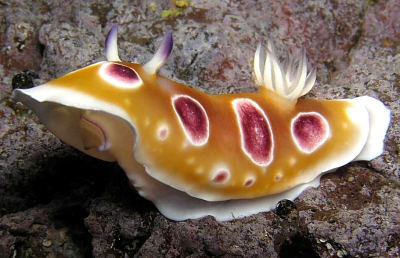
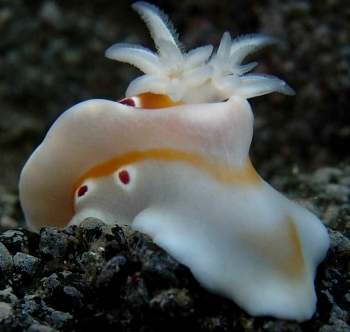
Concerning message #19851:
Dear Bill,
Reunion Island seaslugs
Over the last 2 years I have seen 6 specimens of this species always on the rocky coast of Etang sale. The size is range from 20-25 mm [lower photo] to 80 mm [upper photo]. They present always the same pattern coloration and are really different from other species of Chromodoris found in our Island. (C. geminus for example)
Locality: Etang salé, Less than 1 m, Réunion Island, Indian ocean, Rocky coast. Length: 20 to 80 mm. Photographer: Philibert Bidgrain.
What's your opinion about this species? A new one?
Philibert Bidgrain
http://vieoceane.free.fr/runseaslug/indexslug.htm
pbidgrain@yahoo.fr
Bidgrain, P., 2007 (May 4) About Chromodoris cf geminus from Reunion Island. [Message in] Sea Slug Forum. Australian Museum, Sydney. Available from http://www.seaslugforum.net/find/19868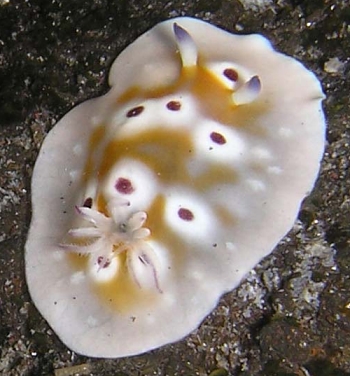
Dear Philibert,
This is an interesting find and supplements Hugues Flodrops message [#19862 ] very well. Certainly the large animal looks very similar to the South African animals I have been calling Chromodoris cf geminus, but the smaller animal in the lower photo seems to link it to the animals I am identifying from Reunion as C. cavae. In particular look at the colour of the gills and the rhinophores. That would suggest that C. cf. geminus from South Africa is a particularly extreme variation because in that form the rhinophores are all purple and the gills are edged in purple. This may seem a much bigger degree of colour variation than we normally find in chromodorids, but if you look at the animals in your other two messages [#19869, #19870] and Marina Poddubetskaia's from Mauritius [#8271] they all seem to link together very well. I have discussed this all in a separate message [#19876 ]
Best wishes,
Bill Rudman
Chromodoris cavae from Reunion Island?
May 3, 2007
From: Hugues Flodrops
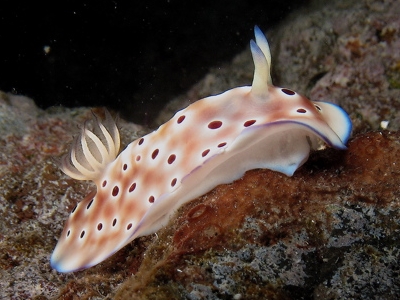
Concerning message #19782:
Dear Bill,
I found this chromodorid three weeks ago. It seemed to be a tropical western Pacific species. In the "Risbecia tryoni colour group" of Reunion Island we often saw Chromodoris geminus and Chromodoris cf geminus. Is it a Risbecia tryoni with pale blue rhinophore? or other species?
Locality: Rocky Coast Etang-Salé, 1 metre, Reunion Island, Indian Ocean, 5 April 2007. Length: 40 mm. Photographer: Hugues Flodrops.
Thanks for your help to identification.
Best regards.
Hugues.
hugues.flodrops@wanadoo.fr
Flodrops,H., 2007 (May 3) Chromodoris cavae from Reunion Island?. [Message in] Sea Slug Forum. Australian Museum, Sydney. Available from http://www.seaslugforum.net/find/19851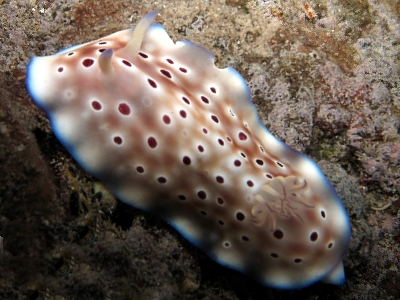
Dear Hugues,
This is another one which should be considered part of the "Risbecia tryoni group" of similarly coloured species. From the relatively low profile of the body I am pretty sure it is not R. tryoni but a species of Chromodoris, and the most likely species is Chromodoris cavae. There are a number of species which have been described from the Indian Ocean - C. cavae, C.vicina and C. tennentana - which are still a bit confusing. Hopefully as we get more information - and photos like yours, we will b able to work out just how any species there are in this group.
You mention finding Chromodoris cf geminus at Reunion Is. I would like to see some photos of it from there.
Best wishes,
Bill Rudman
Chromodoris cavae from India
January 29, 2003
From: K. Padmakumar
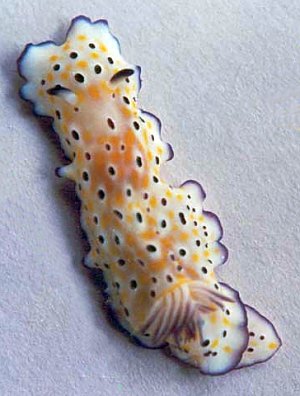
Dear Bill.
I am a regular visitor of your wonderful web site. The picture in the message you identified some years ago as possibly being Chromodoris tennentana. But there are some differences in the radula pattern than that reported by you. It was collected from
Mandapam, Gulf of Mannar.
Wishing you a Happy and prosperous 2003!
K. Padmakumar,
University of Kerala.
kpkumar@md4.vsnl.net.in
Padmakumar, K., 2003 (Jan 29) Chromodoris cavae from India. [Message in] Sea Slug Forum. Australian Museum, Sydney. Available from http://www.seaslugforum.net/find/8894Dear Padmakumar,
This is a every interesting photo. Since my earlier tentative identification I have seen more photos of C. tennentana and a photo which seems to be C. cavae from South Africa. Your photo is a very good match for the original painting of C. cavae, and helps to differentiate the two species. One very constant difference would appear to be the colour of the gills, which in C. cavae are white with purple edging, while in C. tennentana they are edged with brown. Also in C. cavae the purple and yellowish spots are scattered all over the mantle while in C. tennentana putple spots are restricted to the central part of the mantle and yellow to the outer part.
Best wishes,
Bill Rudman
Rediscovery of Chromodoris cavae Eliot, 1904
November 13, 1999
From: Bill Rudman.
Valda Fraser's interesting photo of a Chromodoris tennentana-like animal and her subsequent reply made me check my old notes to try and solve the puzzle of just what her species was. I am now convinced that it is the real Chromdoris cavae Eliot, 1904, which was described from Zanzibar, East Africa, and never seen again.
Bill Rudman.
Chromodoris vicina? from Sth Africa
November 9, 1999
From: Valda Fraser

Dear Bill,
With reference to Gosliner, T. 1987 NUDIBRANCHS OF SOUTHERN AFRICA. Sea Challengers, I have tentatively identified a specimen as being Chromodoris vicina. Unfortunately, the foot of the animal is not visible in Gosliner's photo. Does it have distinctive yellow spots?
I hope you will be able to help.
Locality: South Coast KwaZulu/Natal - SOUTH AFRICA. Near Port Shepstone, Rocky Reef, 24m, October 1999. Size: 50mm
Regards
Valda Fraser
iti04937@mweb.co.za
Fraser, V., 1999 (Nov 9) Chromodoris vicina? from Sth Africa. [Message in] Sea Slug Forum. Australian Museum, Sydney. Available from http://www.seaslugforum.net/find/1486Dear Valda,
I am not sure that your South African animal is Chromodoris vicina. Some years ago I decided that C. vicina from east Africa was the same as C. tennentana from Sri Lanka. The yellow (orange) spots and dark purple (black) spots seem to differ in proportion and arrangement, but they are possibly variations of each other. I would be interested to know if the underside of the mantle is white or has some colour. In some species the whole of the underside of the mantke at the head end is purple. The foot in animals from Tanazania had a marginal row of dark spots and a submarginal row of yellow spots. In your animals the submarginal yellow spots are present and it is possible that the marginal row of dark spots has become the purple edge to the foot.
Similar colour variants occur in a similarly coloured western Pacific species, Chromodoris collingwoodi, which I will try and finish a page about this week.
Sorry I can't be definite. It's only as we begin to get some idea of the variation and geographic range of these animals that we begin to make sense of these relationships. That's why I am happy to publish photos of the same species from different localities.
Best wishes,
Bill Rudman.
